We’re sharing the pros and cons that we discovered after using the Speedheater 1100, an infrared paint stripping tool. Is it right for you? Let’s talk about it!
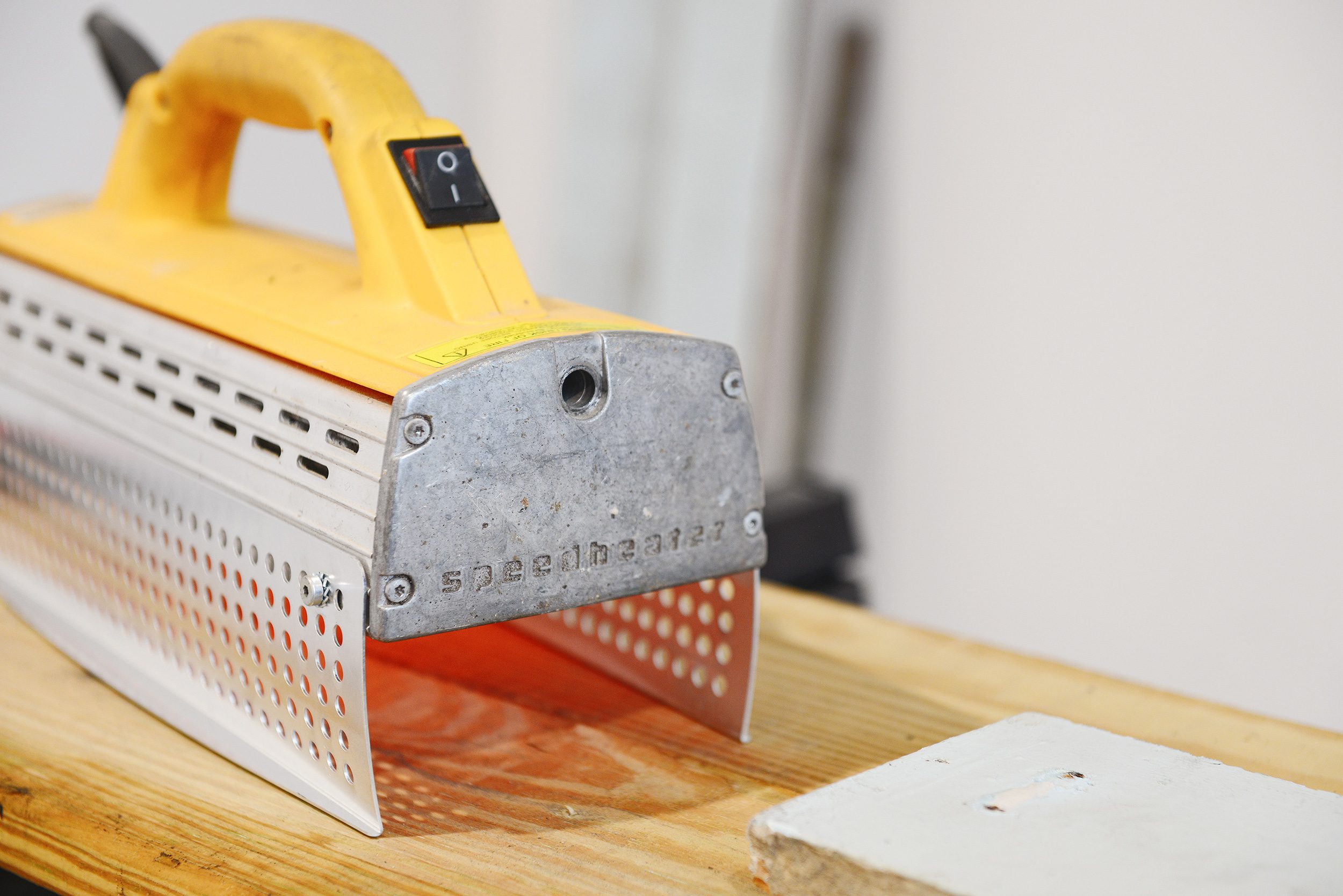

Even though we’ve decided to hire out the installation of all new millwork and trim at our ongoing Two Flat Project, we still plan on restoring the original wood doors and built-in hutch! We first purchased the Speedheater 1100, an infrared paint stripping tool designed to safely remove paint from wood surfaces, to revive the millwork, but we think it will come in handy for doors and various projects down the road. When Kim shared the Speedheater in Stories, her DMs quickly filled with questions! We had a hard time finding personal reviews of the tool online, so we wanted to throw our experience into the ring, in the hopes it could help you if the time comes.
The Speedheater 1100
The 1100 (pictured throughout this post) is the bigger of the two available sizes and is designed to remove paint from large surface areas like trim, doors, and siding. The 1100’s little brother, the Speedheater Cobra, works similarly, but in a smaller handheld package that’s designed to remove paint from windows and furniture. We’ll focus on the Speedheater 1100 here, as the units are functionally identical, but each likely has its own benefits.
The Pros
The Speedheater is a very specific tool for a very specific job. If there is a large quantity of paint to be stripped from a large surface area, it’s rated to be among the best, which is what attracted us to it. Here’s why:
1| Safety
The Speedheater uses infrared technology to gently heat and soften paint so that it can be easily scraped away using standard paint scraping tools. The benefit of using infrared heat as opposed to a heat gun is the lower temperature at which infrared heating is effective. If you’re dealing with lead based paint, this is extraordinarily important! Lead paint vaporizes at 752 degrees Fahrenheit and produces poisonous fumes. The Speedheater works at much lower operating temperatures than lead’s vaporizing point, so is a significantly safer option than a heat gun or similar tool. That said, we still took lots of precautions during use and placed disposable drop cloths around our work surface. We also kept windows open for ventilation and wore gloves, masks and glasses while we worked.
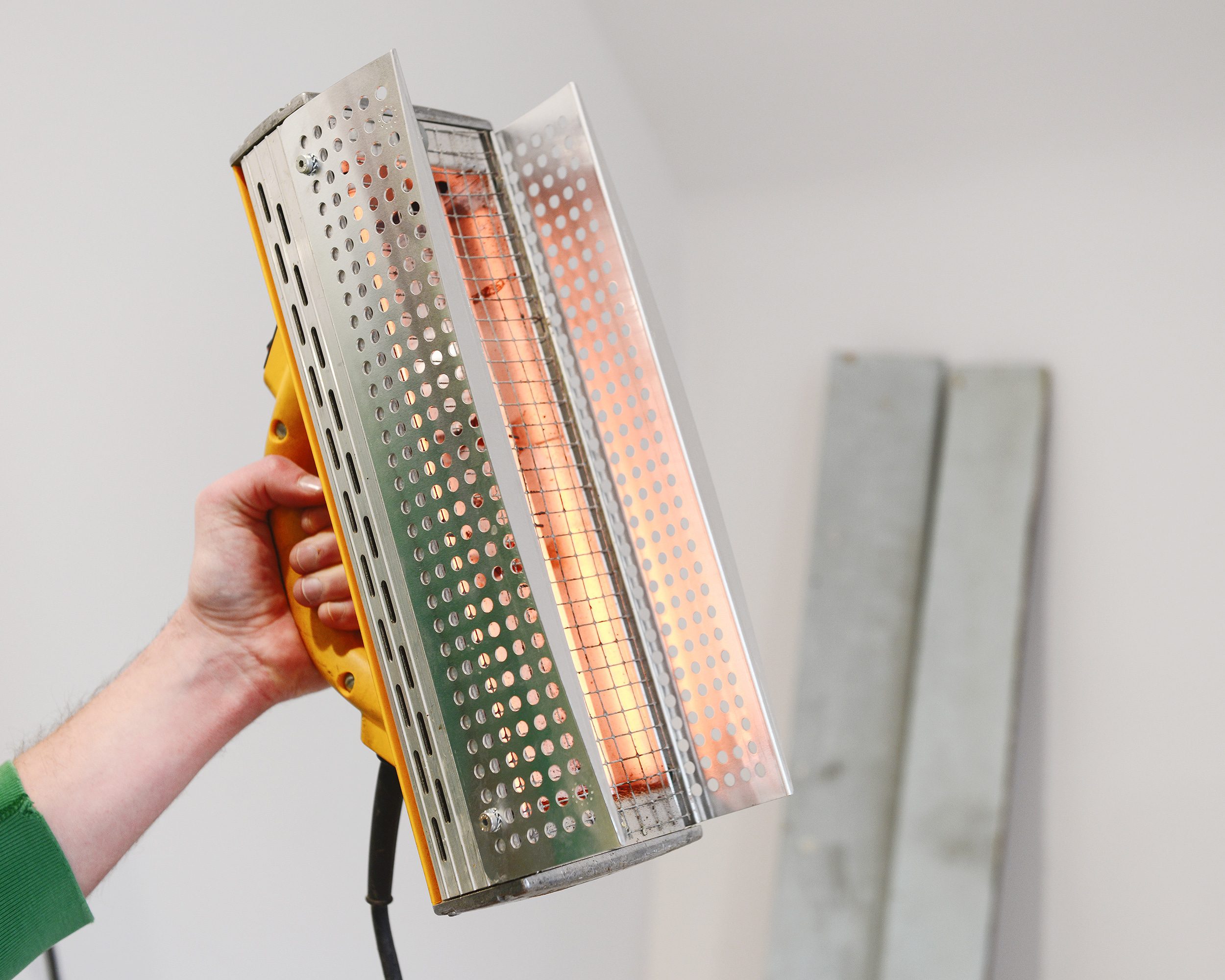

Lead paint vaporizes at 752 degrees Fahrenheit and produces poisonous fumes. The Speedheater works at much lower operating temperatures than lead’s vaporizing point, so is a significantly safer option than a heat gun or similar tool. That said, we still took lots of precautions during use and placed disposable drop cloths around our work surface. We also kept windows open for ventilation and wore gloves, masks and glasses while we worked.
2| Speed
The Speedheater 1100 heats an area of 3″ x 11″ in 20-40 seconds depending largely on the age, quantity and type of paint being removed. The nice thing about using the larger unit for trim and millwork is that one area can be scraped while the next area is being heated, and so on. That was a huge selling point for us! This ‘leapfrogging’ techniqe nearly eliminated down time between patches and makes for quick work. We were able to remove the vast majority of paint from a roughly 5 foot trim board in 2-3 minutes. Our trim will eventually be painted, so we weren’t concerned with total perfection. If wood will be restored to stain-grade, we’d estimate the time would double.
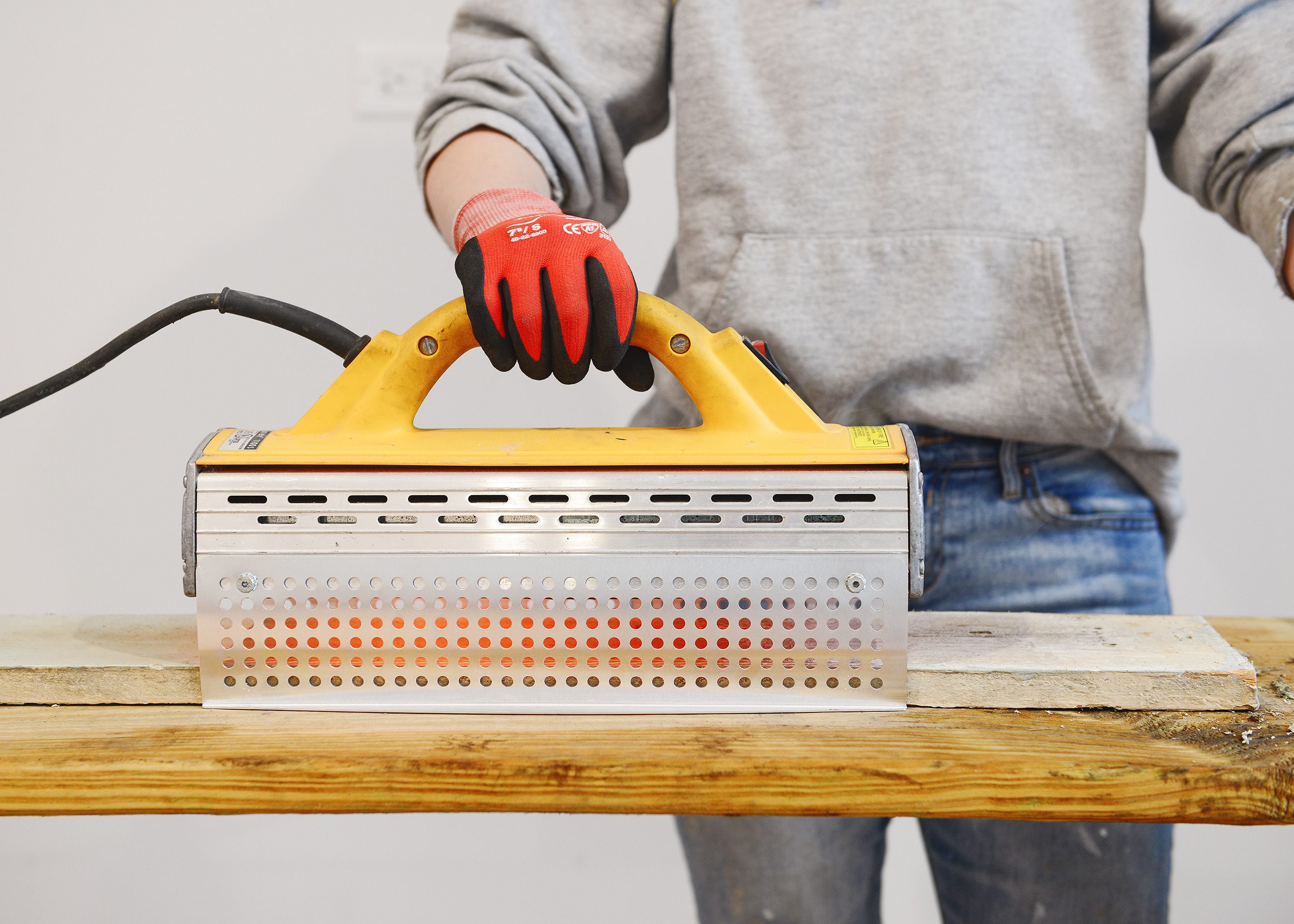

3| (Relative) Cleanliness
We have used and loved gel strippers like Citristrip in the past but, man, are they messy! Where gel strippers liquify paint into a sticky slurry of gloop, the Speedheater allows paint to be scraped off cleanly with virtually no dust. The paint from our millwork shaved off and gathered on the floor, where we had previously laid a drop cloth. Tip: This scraper was our best friend.
The Cons
While the Speedheater certainly has its benefits, stripping paint is rarely a perfect science. Below are our thoughts on the drawbacks to using this clever tool on your next project.
1| Expense
The Speedheater 1100 kit costs $599 from their only US distributor, Eco-Strip. We absolutely understand why the tool costs what it does, but we felt that we simply wouldn’t use it enough to justify the cost. Instead, we went on a hunt in which we scoured Craigslist, eBay and Facebook Marketplace to find a secondhand Speedheater to minimize the initial investment. We couldn’t find a unit locally, so we widened our search and found a perfectly functioning unit in Louisville, KY, in which the seller agreed to have it shipped to Chicago with insurance.
We’re hopeful that we can use it while restoring the Two Flat and break even by reselling it when we’re done. From what we can tell, the current going rate for the 1100 unit in good condition is around $250 – $350 before shipping. Speedheaters do pop up on eBay from time to time, so make sure to keep an eye out. Happy hunting!
2| There’s a learning curve
This is the case with anything, right? We read a lot of articles before starting, and truthfully, we’re still a little unsure of how to use The Classic Arm that came with ours! At one point, the Speedheater was left on a few seconds too long, and a small section of board caught flame. (It was blown out easily and quickly, but it gave us a scare!) It took us several passes to learn how long to leave the Speedheater on each section of board, and once we figured that out, the next challenge was getting down our scraping technique.
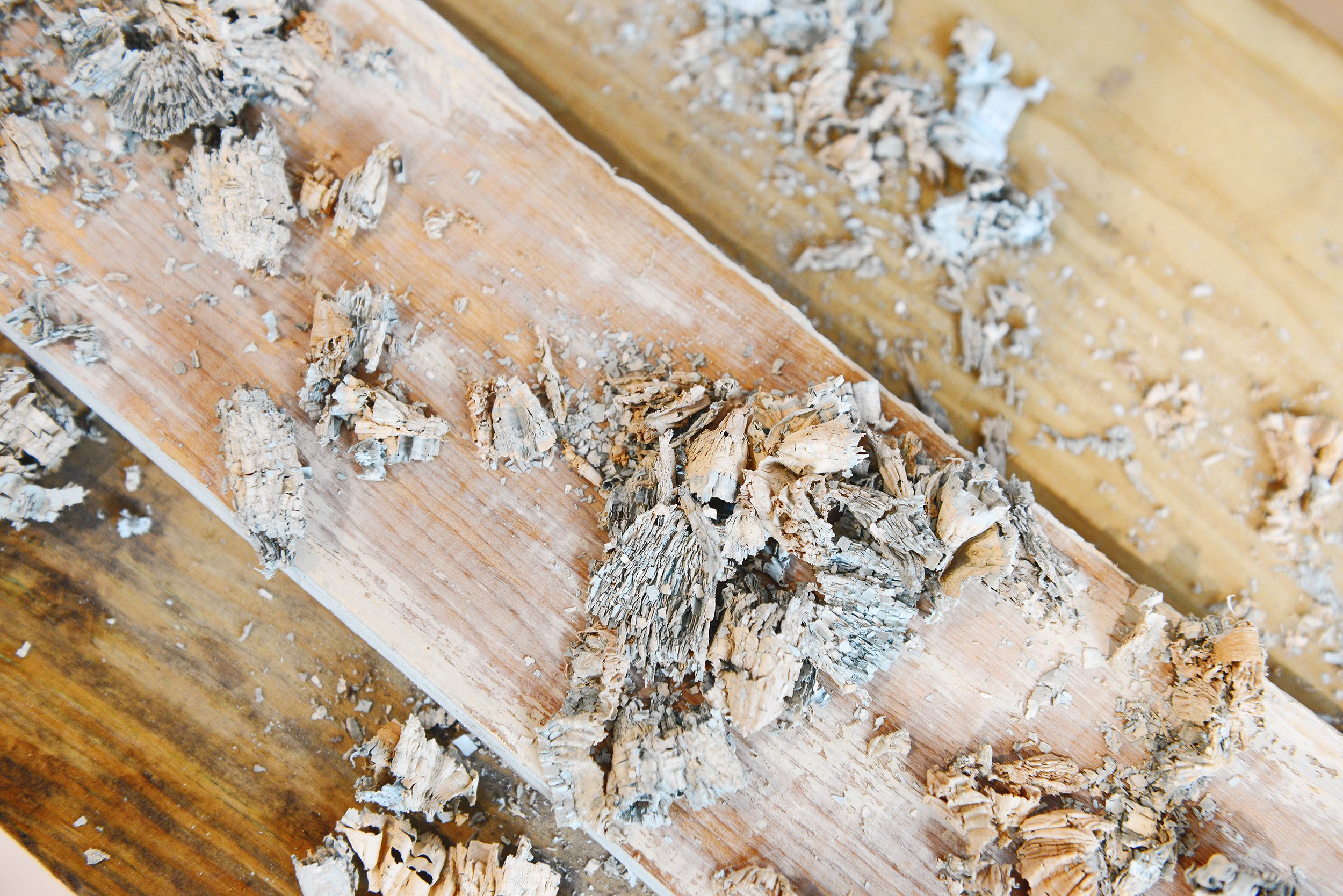

3| It’s a one-trick pony
The Speedheater is a bit of a one-trick pony. It performs its one intended function incredibly well – removing paint from wood. What it (supposedly) doesn’t do as well is… anything else. Per the manufacturer, Speedheaters ‘quickly heat varnish, oil-based, latex, acrylic, or plastic paint. They do not work on shellac, milk paint, or stain.’ Apparently, there are methods for utilizing the tool for removing paint from brick, marble, concrete and fiberglass, but with significantly more time and effort involved. To us, $600 seems like a lot of money to spend on a tool with such limited uses.
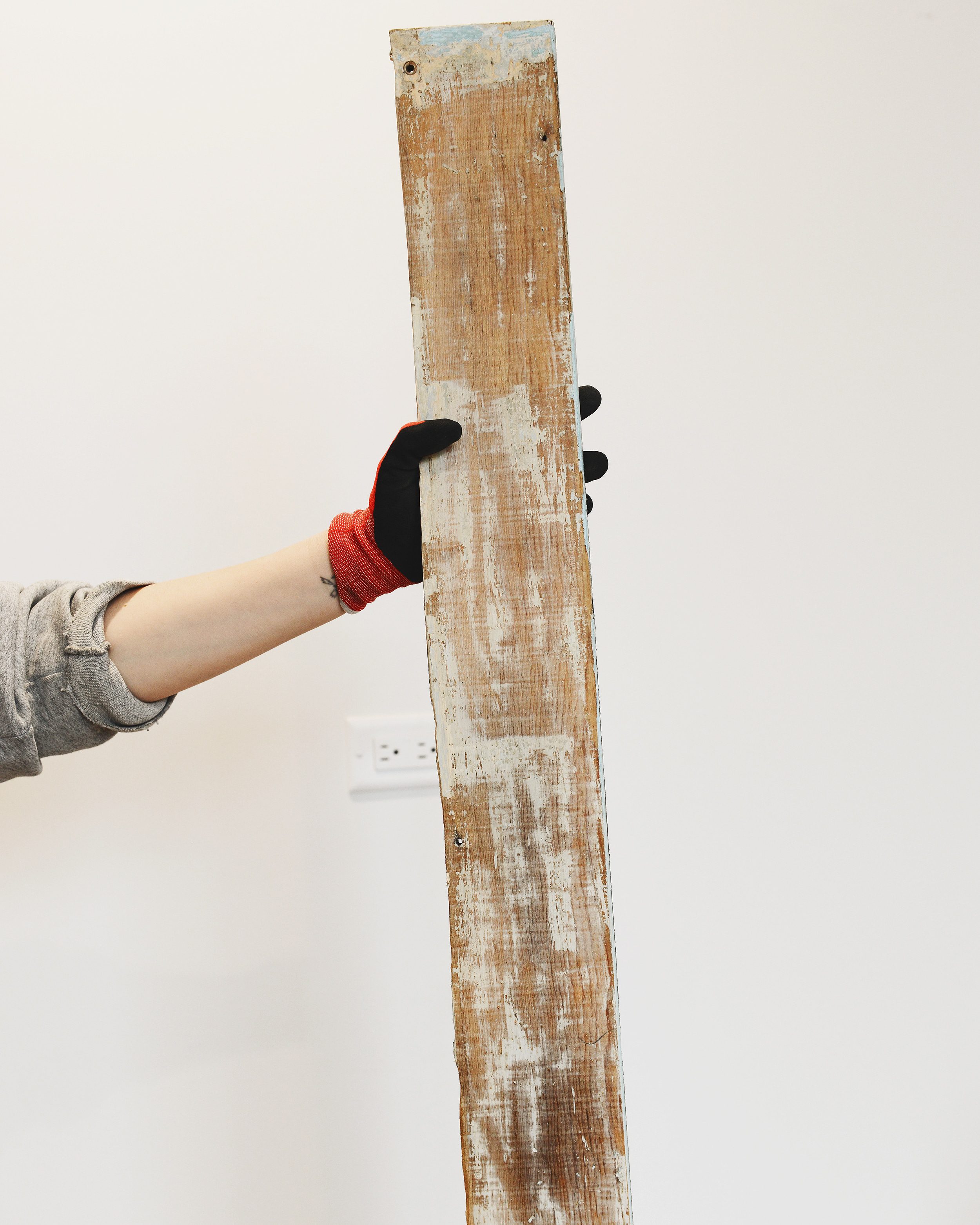

So, Should I Buy One?
This is the question we asked ourselves for weeks before taking the plune. Here’s our take: If you have a large scale wood restoration project in your near future (or restore wood frequently or professionally), the time that the Speedheater 1100 or Cobra could save might make for an incredibly worthwhile investment.
The Speedheater allows for nearly instant paint removal when compared to a gel stripper like Citristrip, which requires wait times of up to 24 hours, depending on the type of paint you’re stripping. That said, the 24 hour wait times don’t mean 24 hours of work. It’s inactive waiting, while the Speedheater requires constant repetitive work.
All that said, the Speedheater might be the perfect addition to your tool arsenal if there is a lot of paint removal in your future, but not if you only have one project in your queue, or don’t see continued use in the future. If you fall in the latter, the expense might not make sense. The great news is that Speedheaters can be tough to find on the secondhand market (perhaps a testament to how much Speedheater owners love theirs?), so fingers crossed you likely wouldn’t have a hard time reselling it when you’re through!
Have you used a Speedheater, and if so, what was your experience?










I bought the Cobra for restoring my home’s original windows and it’s life changing. It allows me to easily scrape off 80 years of paint and softens the glazing putty so I’m less likely to crack the glass. The mess is far more contained and easier to clean up than strippers or scraping/sanding. It’s definitely worth the investment.
Alicia – same here! We were two windows in and had already gone through at least three large bottles of Citristrip when I decided to bite the bullet and get one. We originally got an estimate of $900 a window (x 14 windows) to have them restored – so it ended up being a big savings to diy with the Cobra. Restoring our old wood windows has been one of the most satisfying (and surprisingly doable) projects we’ve done!
It seems like it would be worth it for a big project…but only secondhand like you say!
Well, think about that logic… If *you* buy it new, and use it, then sell it to someone else for half the price, you *still* ended up paying 50%, yet you enjoyed a brand new tool.
I own both the Speedheater, and a $20 heat gun. I’ve used them both to remove paint off many 160-year old doors and interior trim. I slightly prefer using the heat gun because if you get a rhythm of heating the area ahead of a 2-inch putty knife, you can push the putty knife along non-stop at a slow but constant pace that feels satisfying. With the Speedheater, I always felt rushed to quickly scrape the whole work area before the paint hardened again… It was slightly stressful. And I tended to scorch the wood more often with the Speedheater, since it’s harder to see what’s going on. That said, I’m going to try stripping some clapboards… I don’t think I’ll bother trying the heat gun for that since the Speedheater seems optimized for that width of working area. Still, if it doesn’t work better than it did on my doors, I may just replace the clapboards all together. I’m so tired of dealing with lead paint, dust, protections, etc.
There probably won’t be a time I’ll ever use this, but my little nerd heart loves how thoroughly y’all have laid out the specs, pros, and cons. Thank you for creating such a valuable resource in YBH — I know I can trust y’all’s recommendations and tips because of that thoroughness. <3 <3 <3
Thank you! We are over researchers through and through.
I stripped a great deal of door and window trim in our nearly 90-year old house with Citristrip and have to say that the work involved, not including the passive wait time, is extensive! The goo must be scraped then removed with sponges and cleaner before the wood can even be sanded. With 1/16″ to 1/8″ thickness of paint, it took several coats, waiting and scraping to get the wood clean. It also produced so much lead-laden goo that I felt I had created more of a hazard.
I stripped window sashes and glazing putty with a heat gun. In retrospect, it would have been at least four times faster, in terms of hands-on time alone, to use the heat gun and would have produced much less mess and a cleaner final product. I am considering the Speedheater for some large areas still to be completed (bead board, doors, etc). Regardless, I will be using heat.
The Citristrip did work well on clear-coated stained wood but again removing the final goo layer was challenging.
We love Citristrip for smaller projects, but it would surely be intense for something larger! There’s just not really a fast fool proof way for any of this. It’s all a labor of love.
I bought a Speedheater years ago when they were still $400. $599 now? Wow! Anyway, I love this tool. I’ve used it for lots of projects around our, now, 111 year old house. As stated in the article, it’s pretty specific in its applicability. I’ve run into some paint (presumed to be milk paint) that just laughs at it. One of the additional uses I’ve found for it is that it’s very good at softening ancient, rock hard window glazing. One has to be very careful, especially if you want to save the wavy glass, but I found it very useful for that purpose.
I have several (ultimately about 60 windows!!) to strip, plus wood doors and trim. The previous owners also painted the stone foundation with a non-breathable paint that I would like to strip. I think that at least for the wood this could be a good investment, but with both windows and doors & trim, I can’t decide if I should be considering the Cobra or the 1100. Any thoughts from people in a similar predicament?
Go for the 1100. I’m in the same predicament (although, only 24 windows), and bought the 1100. The cobra is just too small — and I don’t think it has the arm where you can prop it up to direct at the glazing putty more directly? It’s been a couple years since I bought mine/researched.
We recommend the Cobra for windows, doors and trim. It fits easier in tight spaces like window panes, corners of trim, and stairs & rail spindles. The Cobra is 10x (less than 5 seconds on paint) faster but on a smaller 3″X3″ area vs. the 20-60 seconds on a 3″x10″ of the SH1100. SH1100 works best of large flat areas like siding. Cobra does have a support bar on it and adjustable head to fit it at the same angle as the putty.
Hi Catherine – I have ~12-15 doors with upwards of 90 years worth of paint on them that I’d like to remove. I was about to pull the trigger on the SH1100 but wondered if you’d recommend the Cobra instead? They’re almost all 5 panel doors so there is some detail but when you consider the sheer amount of space covered on that many doors, it’s quite a bit.
I have the 1100 and the cobra. I use them both for my 45 window project. The expense divided by 45 is minimal and the result as well as time saved made it worthwhile. There is a learning curve and the importance of having a variety of chisels , scrapers and putty knives makes it all doable. Also patience
The final task for me with the Cobra is removing old putty. Is that an easy process?
When we first bought my grandmother’s now 107 yr old brick craftsman we knew for sure it was filled with lead paint. We had the walls sealed behind new plasterboard (benefit hose is pretty soundproofed) We pulled all the doors, baseboards & trims for dip stripping. BIG BUT, we are now left with the inner parts of doorways & windows inside & out. To me the cobra sounds perfect if expensive. Add a tiny bath for someone painted white. The woods are an unusual mix of heart pine & old forest growth woods so I definitely hesitate @ heat guns. Whatever replacements including kitchen, damages bath & addition are all reclaimed heart pine. If anyone out there has a used cobra we’re definitely interested.